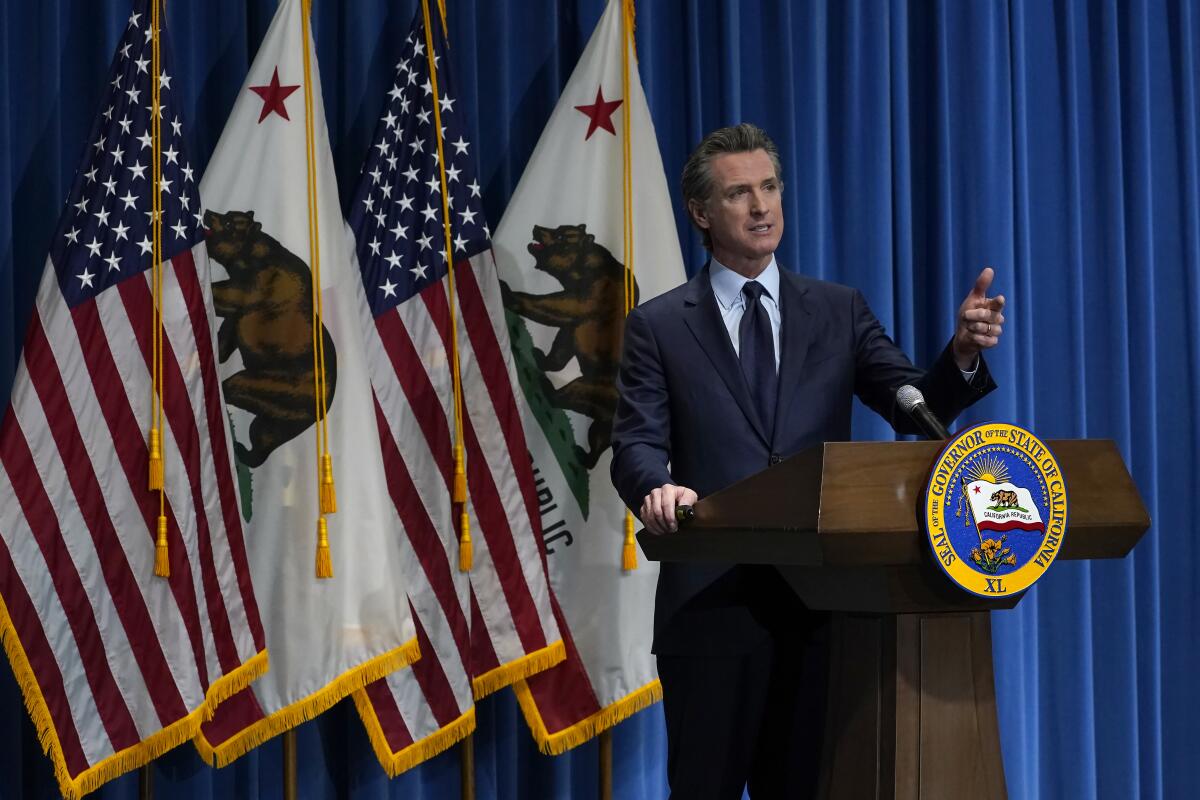Newsom’s state budget earmarks billions in COVID-19 help for workers and schools

- Share via
SACRAMENTO — Gov. Gavin Newsom sent a budget to the California Legislature on Friday that calls for a swift and expansive boost in the state government’s response to the COVID-19 pandemic, earmarking much of an unallocated tax revenue windfall for efforts to help workers and businesses, boost public health and speed up the reopening of public school classrooms.
In all, the proposal dedicates more than $14 billion to an array of coronavirus relief initiatives, while setting aside money in support of virus vaccination efforts and almost $3 billion in short-term cash reserves if additional needs arise. Newsom urged lawmakers to take action on the most pressing issues — including an extension of the state’s moratorium on evictions and funding for California’s COVID-19 vaccination push — by the end of the month.
“We can’t wait,” Newsom said during a lengthy budget presentation in Sacramento. “In this environment, you can’t wait.”
The centerpiece of the governor’s economic stimulus plan — a $4.5-billion blueprint announced on Wednesday — would provide cash infusions to existing state programs that offer tax credits to businesses and apprenticeship programs affiliated with community colleges. Money would also go toward expediting housing construction in urban and neighborhood settings, and subsidies for low-income Californians to purchase zero-emissions cars and trucks. An additional $500 million would be available for tax credits to encourage the creation of additional housing for low-income Californians.
“It’s an incredible moment in terms of anxiety, but an incredible moment of opportunity to address these issues,” the governor said.
Newsom has also proposed cash payments of $600 to the state’s lowest-wage workers, funds he said he hopes will be distributed in February and March and estimated to cost $2.4 billion. His budget plan also asks lawmakers to fast-track the use of $2.6 billion in federal funds for struggling tenants and new assistance for property owners whose mortgage payments are in jeopardy as a result of unpaid rent.
While Democratic legislative leaders applauded the governor’s proposals, there were hints of the concerns raised last year over the Legislature’s ability to oversee major spending decisions done quickly in response to the ongoing health emergency. Assembly Speaker Anthony Rendon (D-Lakewood) called for “careful oversight” of pandemic relief expenses.
“We want to make sure that relief for the unemployed, small businesses, nonprofits and others is distributed equitably and efficiently. The same kind of careful budgeting over the last decade provided the surplus that softened the blow from COVID in 2020,” Rendon said in a statement.
Newsom’s ability to take action on his own could extend to spending money in support of vaccination efforts across California. His budget, finalized weeks before the vaccines were approved by federal officials, sets aside $372 million for state-sponsored efforts. While local officials and health providers have a more direct role in the distribution of vaccines, the governor said Friday that he believes at least 1 million COVID-19 vaccine injections should be completed by Jan. 17.
“Here’s your next thing to hold me accountable to,” he said of the pledge.
The budget proposal anticipates that even while some sectors of the California workforce have remained steady, the high demand for unemployment benefits will continue. Newsom’s proposal expects the state to borrow $48.3 billion from a federal unemployment trust fund to cover benefits provided to state residents. Federal rules require states to pay interest on those loans, and California officials expect that borrowing to cost $555 million in the coming fiscal year. The governor’s budget also includes $11.4 million for the California Department of Technology to review and improve services in select, key departments including the Employment Development Department.
Not all of the governor’s proposals offer additional money to solve pressing problems. The plan he unveiled last week for some of California’s youngest students to return to classrooms in February relies on $2 billion in tax revenues already guaranteed to public schools by the state Constitution. Newsom’s proposal would dole out those dollars differently: School districts that complete COVID-19 safety plans for in-person instruction by Feb. 1 would receive at least $450 and up to $800 per student for pandemic-related needs — even if local virus transmission rates are too high for students to return next month.
Schools that don’t complete the planning process until March 1 will receive smaller per-pupil grants. The plan would require participating public schools to offer all elementary school students the option to attend at least some classes on campus by mid-March if public health conditions permit it.
But those school reopening deadlines can’t be met if the Legislature doesn’t take action on the plan this month. Even then, school district officials could find the governor’s timeline to be challenging. One large hurdle could be that the reopening plans must have the endorsement of the local labor unions representing teachers and school employees.
Schools would also be encouraged to offer new summer programs and additional efforts to lessen the blow from learning setbacks caused by remote schooling. In all, Newsom’s plan sets aside $4.6 billion for those services.
The various proposals unveiled Friday cover both a revision of the existing budget the governor signed into law last summer and his $227.2-billion spending proposal for the fiscal year that begins on July 1. Lawmakers have a larger opportunity this year for a course correction at the midpoint of the current budget cycle, the result of several sectors of the California economy faring better than expected during the first nine months of the public health crisis.
Some of last year’s spending cuts would be reversed if lawmakers adopt Newsom’s plan. Colleges and universities would see, collectively, a $951-million increase in funding for the coming academic year. And spending on the state’s judicial system would rise by $381 million, with a focus on ensuring the pandemic doesn’t create long delays in handling criminal cases. Items prioritized last year — including converting hotels and motels into housing for the state’s homeless population — would continue under the spending plan.
How the state’s financial condition went from risky to robust is a story centered on the uncertainty of economic conditions last spring.
When lawmakers adopted last year’s tax revenue forecast, the expectation was that an unprecedented number of Californians might lose their jobs, with many of them seeking help from the state’s health and human services programs. Unemployment rose sharply through much of 2020, but millions of middle-class and high-wage workers were able to keep their jobs and work from home. Tax collections also rose after the strength in the stock market boosted capital gains earned by the state’s wealthiest taxpayers.
Monthly tax collections through last summer and fall consistently beat expectations. In November, independent legislative analysts predicted last year’s overly pessimistic budget projections could result in as much as $26 billion in unexpected cash for state programs. Newsom’s budget largely agrees with the legislative forecast but assumes that some of the money will be used to fund social safety net programs and that a large portion must, by law, be set aside in California’s long-term cash reserves.
The ripple effects, along with the expectation of additional stimulus and pandemic help from the federal government, could offer state government a sizable shelter from the economic storm. It also could lead to some surprises, none more shocking than the potential for a modest but notable $51 million in taxpayer refunds under an obscure 1979 law that measures expenditures, personal income growth and population to determine whether Californians should get a rebate on their taxes. The final determination of whether that will happen won’t come until the spring.
Times staff writer Patrick McGreevy contributed to this report.
More to Read
Sign up for Essential California
The most important California stories and recommendations in your inbox every morning.
You may occasionally receive promotional content from the Los Angeles Times.











